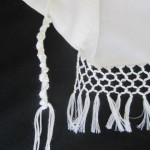Unlike other online tallit sellers, we offer a large range of tzitzit options, which can overwhelm our customers.
What is the difference in the choices between machine-made and hand-spun tzitzit, and thin and thick tzitzit? I’m confused…Also what is the difference between the Askenazi and Chabad tzitzit tying customs? Thanks…Steve R.
Machine-spun is slightly shorter than hand-spun, but for the most part the difference is a halachic matter. Machine-spun is considered a leniency that is widely relied on. Except for top-end traditional black-striped and white-striped tallits, just about every tallit sold today comes with machine-spun standard. If you would like to read about the issue, click here.

Ashkenazi tying and Chabad tying look similar. Both have five double knots, with segments of 7, 8, 11 and 13 windings in between. The difference is that with Ashkenazi tying, you just do simple windings around the core (“gid“), whereas according to the Chabad tying custom, the windings are linked into subgroups of 1, 2 or 3 windings.
Steve didn’t ask about Sephardic tzitzit, but it’s worth mentioning here. Sephardic tzitzit are tied by looping the shamash (the long string) through each of the windings individually. When done properly, this creates a ridge that spirals around the core.

